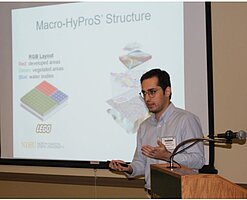Development of the Macro-Scale Hydrologic Processes Simulator (Macro-HyProS) and Applications in the Red River Basin and North Dakota

Mohsen Tahmasebi Nasab is a doctoral candidate and a graduate research and teaching assistant in the Department of Civil and Environmental Engineering at North Dakota State University (NDSU). He received his master’s degree in Hydraulics from the University of Tehran, Iran, in 2014 and started his Ph.D. studies in Civil Engineering at NDSU in 2015. His research project is concerned with topographic analyses and macro-scale modeling of hydrologic processes. Specifically, he is developing a macro-scale hydrologic model which possesses a unique modeling framework and accounts for the cold climate condition in North Dakota.
Email: m.tahmasebinasab@ndsu.edu
Phone: 701-404-3812
Fellow: Mohsen Tahmasebi Nasab, Ph.D. Candidate, Department of Civil and Environmental Engineering, North Dakota State University
Advisor: Xuefeng Chu, Ph.D., Professor, Department of Civil and Environmental Engineering, North Dakota State University.
Development of the Macro-Scale Hydrologic Processes Simulator (Macro-HyProS) and Applications in the Red River Basin and North Dakota
Macro-scale hydrologic models are commonly used to simulate different hydrologic processes and provide a holistic view of water resources over large basins. Although the concept of macro-scale hydrologic modeling is relatively new, many models have been developed over the course of the last three decades. The majority of these models have adopted unique structures to address specific hydrologic needs of their study areas. This project is the continuation of our work partially funded by the 2017 NDWRRI fellowship and is aimed to enhance the developed gridded hydrologic model (GHM) to a macro-scale hydrologic processes simulator (Macro-HyProS). Simulations from the Macro-HyProS provide invaluable hydrologic information that can be utilized by agricultural and environmental decision-making agencies.
Project Objectives:
This project is a part of my Ph.D. dissertation research. The key goals of my Ph.D. dissertation research are:
- to develop the Macro-Scale Hydrologic Processes Simulator (Macro-HyProS), tailored to be used in cold-climate conditions and areas with flat topography;
- to test the Macro-HyProS by coupling it with downscaled meteorological datasets, and applying it to different macro-scale basins within Northern Great Plains; and
- to study the hydrologic issues associated with macro-scale hydrologic modeling including the scaling issue and resolution effects.
Accordingly, the main objectives of this one-year project are: (1) to introduce sub-grid variability into the Macro-HyProS and improve hydrologic simulations over the previously lumped grids, (2) to employ a new topography-based methodology to take depressional and flat regions into account, and (3) to enhance the current methods to meet specific requirements of cold-climate regions. To achieve these objectives, a compilation of existing macro-scale models will be selected and compared with the Macro-HyProS.
Progress:
The initial version of Macro-HyProS was developed with the support of the 2017 NDWRRI fellowship and presented in forms of oral and poster presentations. The basic model has been tested by applying it to (1) the Red River Basin, and (2) the entire State of North Dakota. The simulation results for the Red River Basin were compared with those from the widely-used SWAT model to confirm the accuracy of the most dominant hydrologic processes. Moreover, a joint modeling framework was developed, which linked the grid-based model and the subbasin-based SWAT model and facilitated the inter-calibration. To account for the depression-dominated topography, a new topo-statistical method was developed for analysis of ponding area versus ponding storage of depression-dominated regions. Also, a new procedure was developed to improve the computation of the topographic wetness index for depression-dominated regions.
Significance:
Many macro-scale hydrologic models have been introduced to assist researchers in investigating hydrologic processes. However, macro-scale modeling is a relatively new topic and further work is required to tackle important challenges such as scaling, incorporation of remotely sensed data, and modeling parameter estimation.
The Macro-HyProS simulates hydrologic processes such as evapotranspiration, canopy storage, surface runoff, infiltration, snowpack, snowmelt, and soil water content. These output results for the Red River Basin and North Dakota will help to understand the related hydrologic issues and offer a foundation for evaluating variations in water resources availability under varying climatic conditions.
Research Outcomes:
Journal Papers:
Tahmasebi Nasab, M., Grimm, K., Bazrkar, M. H., Shabani, A., and Chu, X. (2018). “Modeling non-point source pollution in depression-dominated regions with inter-annual runoff variability.” (Status: under Review).
Grimm, K., Tahmasebi Nasab, M., and Chu, X. (2018). “TWI Computations and Topographic Analysis of Depression-Dominated Surfaces.” Water, 10(5), 663.
Chu, X., Lin, Z., Tahmasebi Nasab, M., Zeng, L., Grimm, K., Bazrkar, M. H., Wang, N., Liu, X., Zhang, X., and Zheng, H. (2018). “Macro-scale grid-based and subbasin-based hydrologic modeling: joint simulation and cross-calibration.” Journal of Hydroinformatics, Accepted.
Conference papers:
Tahmasebi Nasab, M., and Chu, X. (2018). “Topo-Statistical Analyses of Ponding Area versus Ponding Storage of Depression-Dominated Regions for Macro-Scale Hydrologic Modeling.” World Environmental and Water Resources Congress 2018, American Society of Civil Engineers, Reston, VA, 415–424.
Oral presentations:
Tahmasebi Nasab, M., and Chu, X. (2018). “Topo-Statistical Analyses of Ponding Area versus Ponding Storage of Depression-Dominated Regions for Macro-Scale Hydrologic Modeling.” ASCE World Environmental and Water Resources Congress 2018, Minneapolis, MN.
Tahmasebi Nasab, M., Grimm, K., Bazrkar, M., and Chu, X. (2018). “Hydrologic and Water Quality Modeling in Depression-Dominated Basins.” ND Water Quality Monitoring Conference, Bismarck, ND.
Bazrkar, M. H., Tahmasebi Nasab, M., Zeng, L., Grimm, K., Wang, N., and Chu, X. (2018). “Drought Identification in Cold Climate Regions: How Can Macro-scale Hydrologic Models Assist Drought Analysis?” 16th Annual Climate Prediction Applications Science Workshop (CPASW), Fargo, ND.
Chu, X., Lin, Z., Tahmasebi Nasab, M., Zeng, L., Grimm, K., Bazrkar, M. H., Liu, X., and Wang, N. (2018). “Joint Grid-based and Subbasin-based Hydrologic Modeling and Application.” ASCE World Environmental and Water Resources Congress 2018, Minneapolis, MN.
Poster Presentations:
Tahmasebi Nasab, M., Zeng, L., Grimm, K., Bazrkar, M. H., Wang, N., Liu, X., Lin, Z., Zhang, X., Zheng, H., and Chu, X. (2018). “Joint Modeling and Cross-calibration of Different Scale Hydrologic Models.” ND EPSCoR Annual Conference, Grand Forks, ND.

Dr. Xuefeng (Michael) Chu
Director, ND Water Resources Research Institute & Civil and Environmental Engineering
Office: CIE 201K
Phone: (701) 231-9758
Email: xuefeng.chu@ndsu.edu


